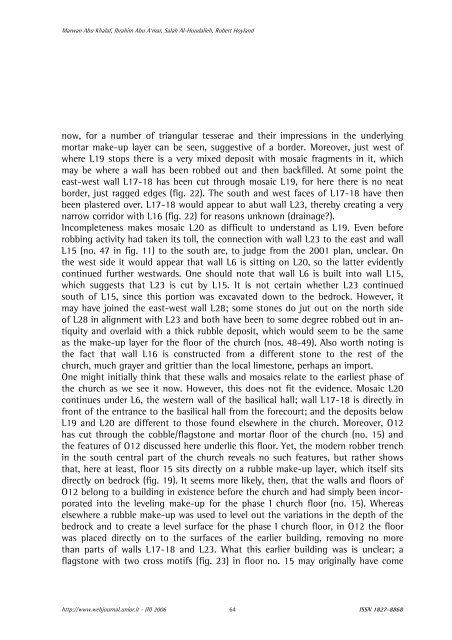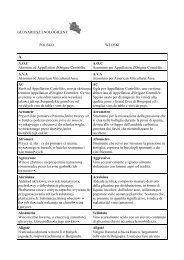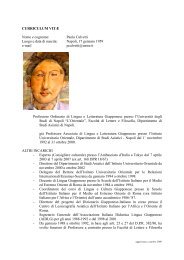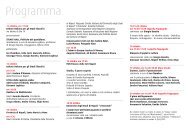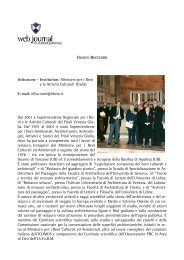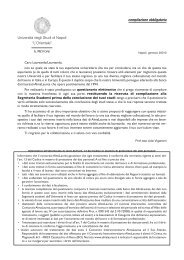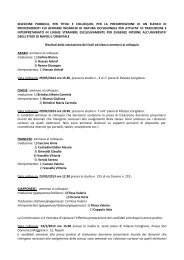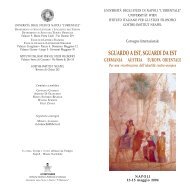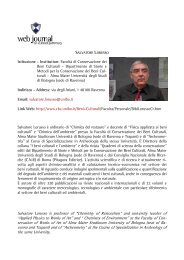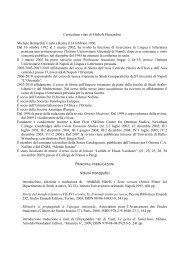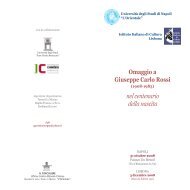The Byzantine and Early Islamic settlement of Khirbat ... - web journal
The Byzantine and Early Islamic settlement of Khirbat ... - web journal
The Byzantine and Early Islamic settlement of Khirbat ... - web journal
Create successful ePaper yourself
Turn your PDF publications into a flip-book with our unique Google optimized e-Paper software.
Marwan Abu Khalaf, Ibrahim Abu A‘mar, Salah Al-Houdalieh, Robert Hoyl<strong>and</strong>now, for a number <strong>of</strong> triangular tesserae <strong>and</strong> their impressions in the underlyingmortar make-up layer can be seen, suggestive <strong>of</strong> a border. Moreover, just west <strong>of</strong>where L19 stops there is a very mixed deposit with mosaic fragments in it, whichmay be where a wall has been robbed out <strong>and</strong> then backfilled. At some point theeast-west wall L17-18 has been cut through mosaic L19, for here there is no neatborder, just ragged edges (fig. 22). <strong>The</strong> south <strong>and</strong> west faces <strong>of</strong> L17-18 have thenbeen plastered over. L17-18 would appear to abut wall L23, thereby creating a verynarrow corridor with L16 (fig. 22) for reasons unknown (drainage?).Incompleteness makes mosaic L20 as difficult to underst<strong>and</strong> as L19. Even beforerobbing activity had taken its toll, the connection with wall L23 to the east <strong>and</strong> wallL15 (no. 47 in fig. 11) to the south are, to judge from the 2001 plan, unclear. Onthe west side it would appear that wall L6 is sitting on L20, so the latter evidentlycontinued further westwards. One should note that wall L6 is built into wall L15,which suggests that L23 is cut by L15. It is not certain whether L23 continuedsouth <strong>of</strong> L15, since this portion was excavated down to the bedrock. However, itmay have joined the east-west wall L28; some stones do jut out on the north side<strong>of</strong> L28 in alignment with L23 <strong>and</strong> both have been to some degree robbed out in an-which would seem to be the sametiquity <strong>and</strong> overlaid with a thick rubble deposit,as the make-up layer for the floor <strong>of</strong> the church (nos. 48-49). Also worth noting isthe fact that wall L16 is constructed from a different stone to the rest <strong>of</strong> thechurch, much grayer <strong>and</strong> grittier than the local limestone, perhaps an import.One might initially think that these walls <strong>and</strong> mosaics relate to the earliest phase <strong>of</strong>the church as we see it now. However, this does not fit the evidence. Mosaic L20continues under L6, the western wall <strong>of</strong> the basilical hall; wall L17-18 is directly infront <strong>of</strong> the entrance to the basilical hall from the forecourt; <strong>and</strong> the deposits belowL19 <strong>and</strong> L20 are different to those found elsewhere in the church. Moreover, O12has cut through the cobble/flagstone <strong>and</strong> mortar floor <strong>of</strong> the church (no. 15) <strong>and</strong>the features <strong>of</strong> O12 discussed here underlie this floor. Yet, the modern robber trenchin the south central part <strong>of</strong> the church reveals no such features, but rather showsthat, here at least, floor 15 sits directly on a rubble make-up layer, which itself sitsdirectly on bedrock (fig. 19). It seems more likely, then, that the walls <strong>and</strong> floors <strong>of</strong>O12 belong to a building in existence before the church <strong>and</strong> had simply been incorporatedinto the leveling make-up for the phase I church floor (no. 15). Whereaselsewhere a rubble make-up was used to level out the variations in the depth <strong>of</strong> thebedrock <strong>and</strong> to create a level surface for the phase I church floor, in O12 the floorwas placed directly on to the surfaces <strong>of</strong> the earlier building, removing no morethan parts <strong>of</strong> walls L17-18 <strong>and</strong> L23. What this earlier building was is unclear; aflagstone with two cross motifs (fig. 23) in floor no. 15 may originally have comehttp://www.<strong>web</strong><strong>journal</strong>.unior.it - (II) 2006 64ISSN 1827-8868


